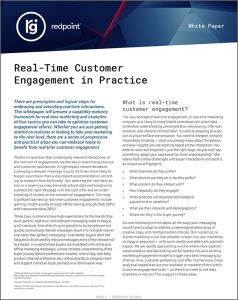Resistance to new ideas is a universal concept, famously espoused by author and sometime inventor Mark Twain, who once said “a person with a new idea is a crank until the idea succeeds.” Marketers know all too well that institutional pushback is part and parcel of devising a novel way to engage with customers. Yet despite the many barriers and limitations – lack of budget, resources or buy-in – good ideas always seem to break through. In trying times like today, marked by rapidly changing and unpredictable customer behaviors and digital transformation acceleration, ambitious marketers can take solace knowing that good ideas are needed more than ever.
What does it mean, though, to be an ambitious marketer? While having the mettle to break through limitations and turn ideas into reality is important, innovation is a key condition – which gets to the essence of the Twain quote. A new campaign idea that is just a new way to reach an existing audience may have a nominal impact. But an idea that results in competitive advantage and drives new revenue has the power to elevate marketing into a mission-critical line of business. Here, resistance comes from all corners; the usual skepticism, mixed with fear of being taken out of one’s comfort zone.
Breaking through the status quo is a strategic imperative. According to the Harris Poll sponsored by Redpoint, 73 percent of consumers say that brands are not meeting their expectation for a personalized, omnichannel customer experience.
Relevance and the Differentiated Experience
Competitive advantage derives from creating something in the market that is completely differentiated. Making a curbside pickup service nominally faster, for instance, may result in an uptick and short-term gains, but is unlikely to deliver sustainable, long-term growth.
True differentiation stems from offering a relevant experience to an individual customer at any stage of their omnichannel customer journey. In a curbside pickup service, that at a minimum would mean offering a seamless experience from the online purchase to the actual pickup, and coordinating logistics so that the right product is available at the right time. Relevance within the context of the journey, however, could mean using geolocation data to send an SMS message alerting an arriving customer of the closest available parking spot. It would mean having an up-to-date record of every customer transaction and behavior combined with every customer identifier – all devices, emails, addresses, social, etc. By possessing this single customer view, a differentiated experience might entail a relevant offer for an accessory item – sent on the customer’s preferred channel and device – at pickup.
Curbside pickup is but one example used to illustrate the broader point that customer journeys are becoming more unpredictable, with more channels, devices and options than ever before – combined with the onset of changing behaviors brought on by today’s uncertainty. The same deep understanding of an individual customer is required to deliver a relevant customer experience wherever the customer chooses to interact.
To some extent, ambitious marketers have always tried to better understand their customers – with various degrees of success. The problem is that dynamic and increasingly digital customer journeys have outpaced traditional customer engagement strategies, which rely on personas, the calendar, batch processing and other antiquated methods that fail to account for today’s truly innovative customer journeys.
Move at the Speed of the Customer
Achieving an understanding of the customer has always involved having the right data. What’s different today is not just the sheer volume of data that’s available, it’s having the right technology in place to turn data into insight. Importantly, making insight actionable with a next-best action must be done at the speed of the customer. The window to provide relevance, in other words, is a short one; a highly relevant interaction could mean making a specific offer based on a web page the customer visited two seconds ago, with a different offer if the customer visited a different page.
Real-time data orchestration and real-time decisioning require automated machine learning to deliver a consistently relevant, individual customer experience at scale. If we circle back to the curbside pickup scenario, we see the importance of not only having real-time data with an updated customer record, but also having intelligent orchestration capabilities that provide the ability to deliver a next-best action wherever the customer appears next in the customer journey.
What this describes – analyzing behavioral, transaction or IoT data across devices, using sentiment analysis, and first-party, second-party, and third-party data across a customer’s anonymous and known customer journey – is the difference between being customer-centric as opposed to persona-centric, which stops at transactional data, preferences and perhaps some survey data. According to research from Gartner, customer-centric brands can achieve up to 20 percent lift vs. roughly 6 to 10 percent for persona-centric brands.
New ideas may always be met with resistance, and some of it may come from within – marketers whose vision of a perfect customer engagement is blocked by frustration over common technology pitfalls. Or a failure to execute a new idea because of data siloes that mask a deep understanding of a customer. But when ambitious marketers are met with pushback, with Redpoint they will have an important ally to break through any limitation; a platform that provides a single point of control over data, decisions and interactions that gives them the power to create innovative customer experiences relevant for today’s dynamic journeys.
The strategic imperative to bring new ideas for engaging with a customer to fruition has never been more urgent. Redpoint is the one solution that empowers brands to transform and deliver customer experiences that succeed in the new reality. It is how ambitious marketers lead markets.
RELATED CONTENT
Digital Transformation Just Became Accelerated
A Contextual Customer Relationship is the Basis for a Superior Experience
Cadence of the Customer and the Corner Store Experience

